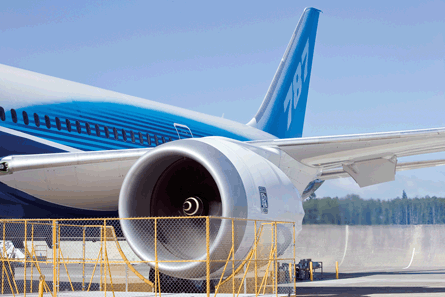Rolls-Royce expects this month to begin bench-testing the first improved variant of the Trent 1000 for the Boeing 787 aimed at bringing the turbofan's specific fuel consumption to "within 1%" of its target.
The upgrade package, which includes a modified low-pressure turbine design, should be flight-tested on the 787 starting in the fourth quarter of this year, although the new standard will not be available for in-service aircraft until after "up to five" 787-8s have been delivered to launch operator All Nippon Airways, says R-R director of Boeing programmes Chris Cholerton.
"The improvement comes along very shortly after [service entry] and we will then roll those early engines out and replace them with the improved standard," says Cholerton. The upgrade is expected to deliver a "1-2%" SFC improvement compared with the version of the Trent 1000 that will launch the 787 into its long-awaited flight test programme, due to begin later this month.
 |
|---|
© Boeing |
"Ideally we'd like to be on spec from day one, so we've got some work to do, but we'll be within 1%," says Cholerton. "We get to spec, if not beyond, with the 787-9, and the confidence for that has come from a demonstrator we've already run this year."
The first iteration of the Trent 1000 has missed its performance targets primarily due to efficiency shortfalls in the low-pressure turbine, and the revised design incorporates a few additional blades.
"The key area was the LP turbine in pushing those high-lift aerodynamics for the benefit of weight. We pushed a little bit too far so that the LP turbine wasn't performing as we wanted it to. There were some flow separations at the tip which was losing performance," says Cholerton.
Looking further ahead, R-R plans to feed back technology being developed for the A350's Trent XWB back into the Trent 1000.
"We've got some further work we want to do in the next year and a half on turbine case cooling/turbine tip clearance control," says Trent 1000 chief engineer Andy Geer. "That's being designed and developed for the XWB now, taking into account some of the lessons we learned during our own development process. They will productionise it and pretty much the same design will be read back to the Trent 1000."
The improved turbine case cooling technology is expected to be available in time for the service entry of the stretched 787-9 with Air New Zealand in 2013. R-R says it bench-tested a Trent 1000 demonstrator engine in February incorporating several modifications that ran "half a percent better than specification", although some of these upgrades will not be available for production Trent 1000s for up to four years.
"That's not where we'll be when we enter service, but it gives us great confidence that what we're doing for the service entry standard is robust," says Cholerton.
Source: Flight International



















